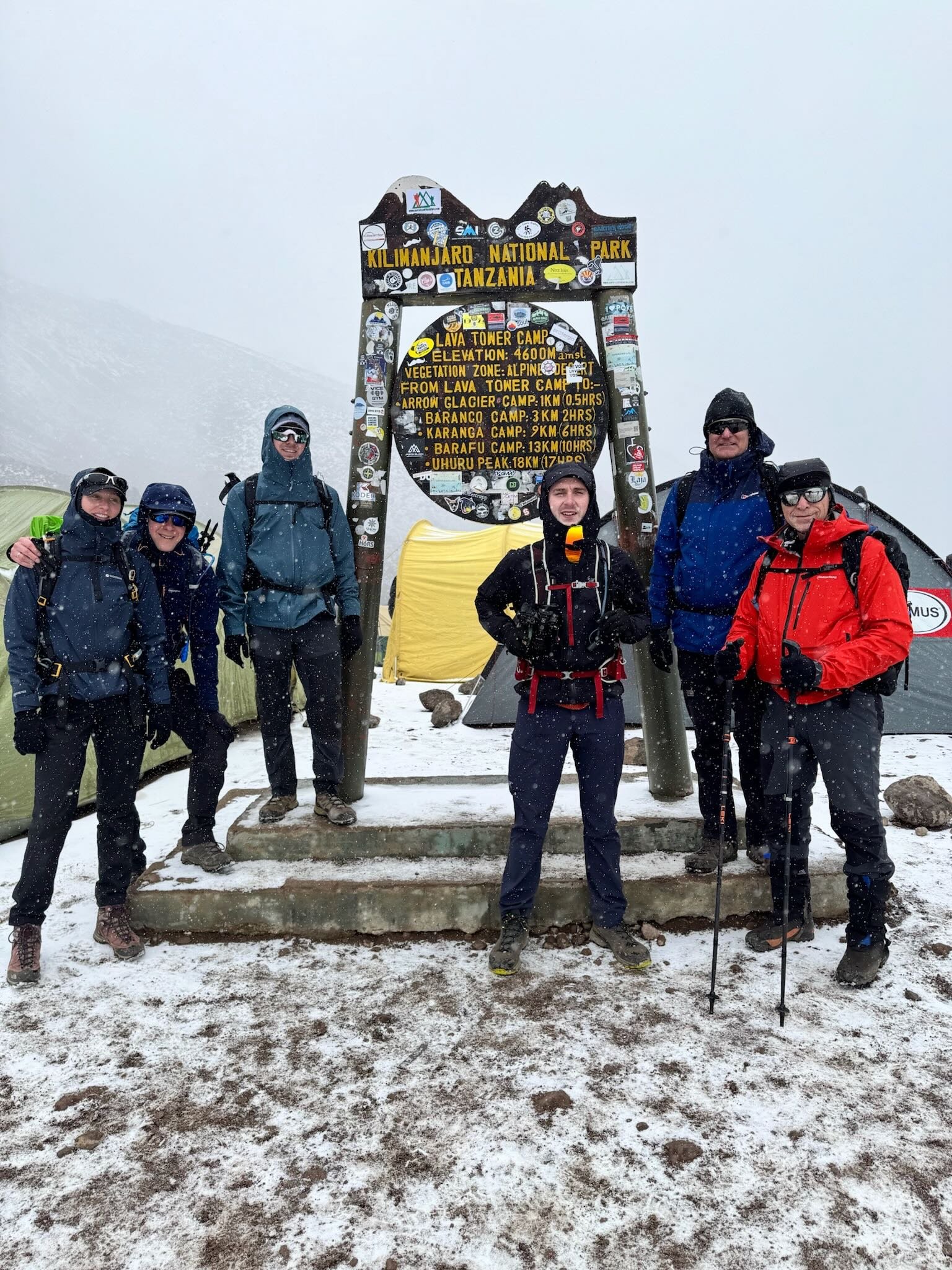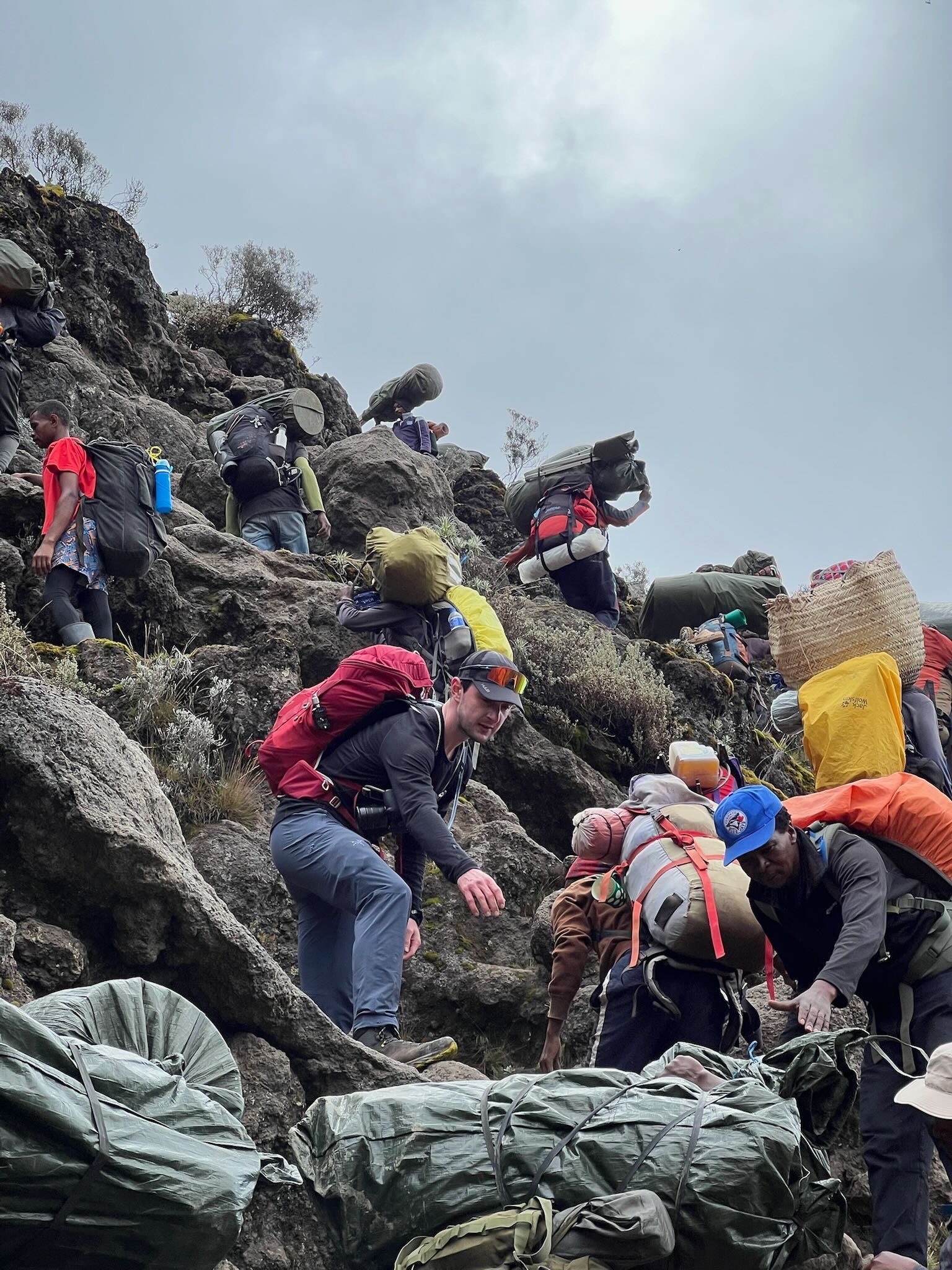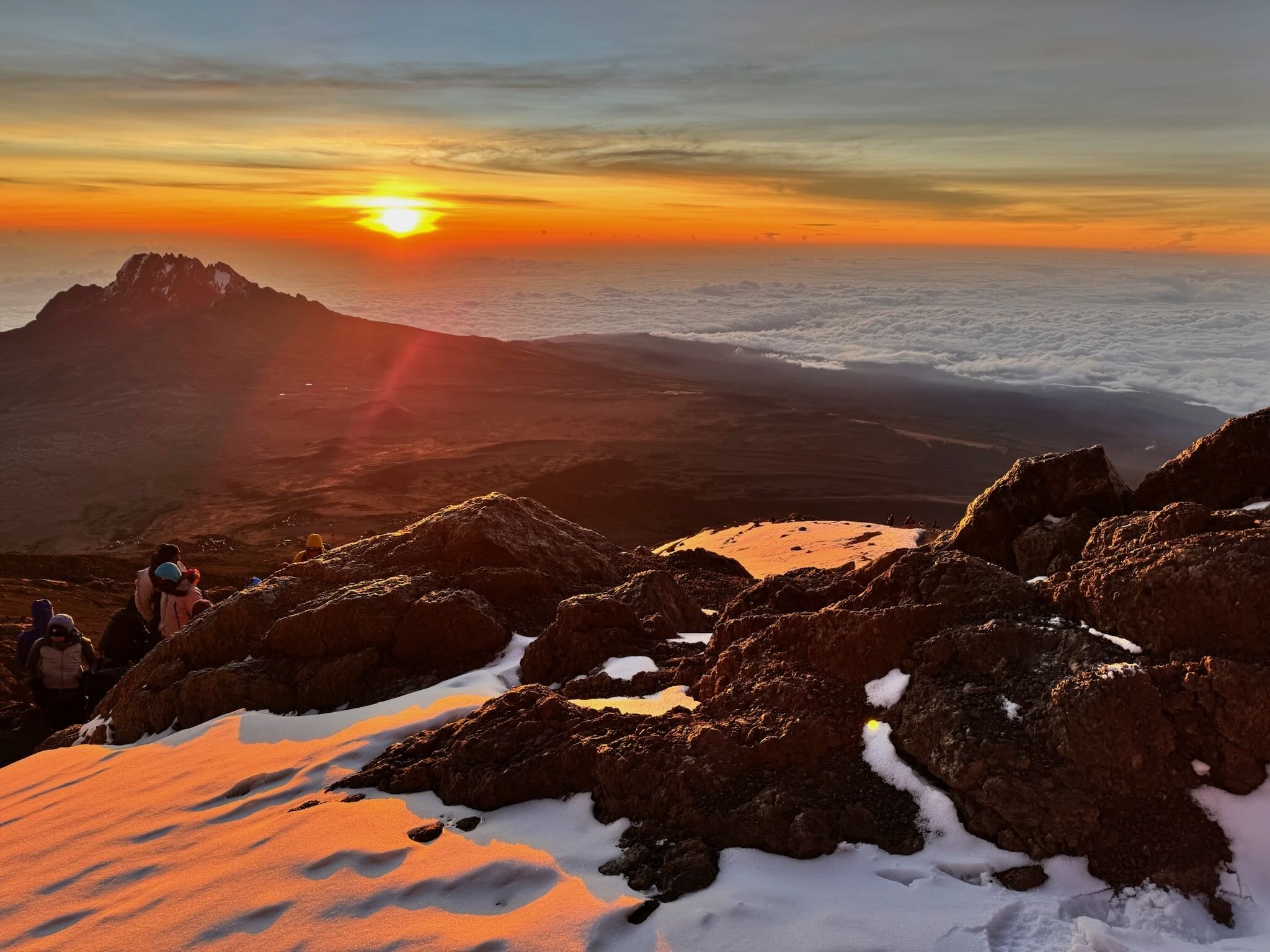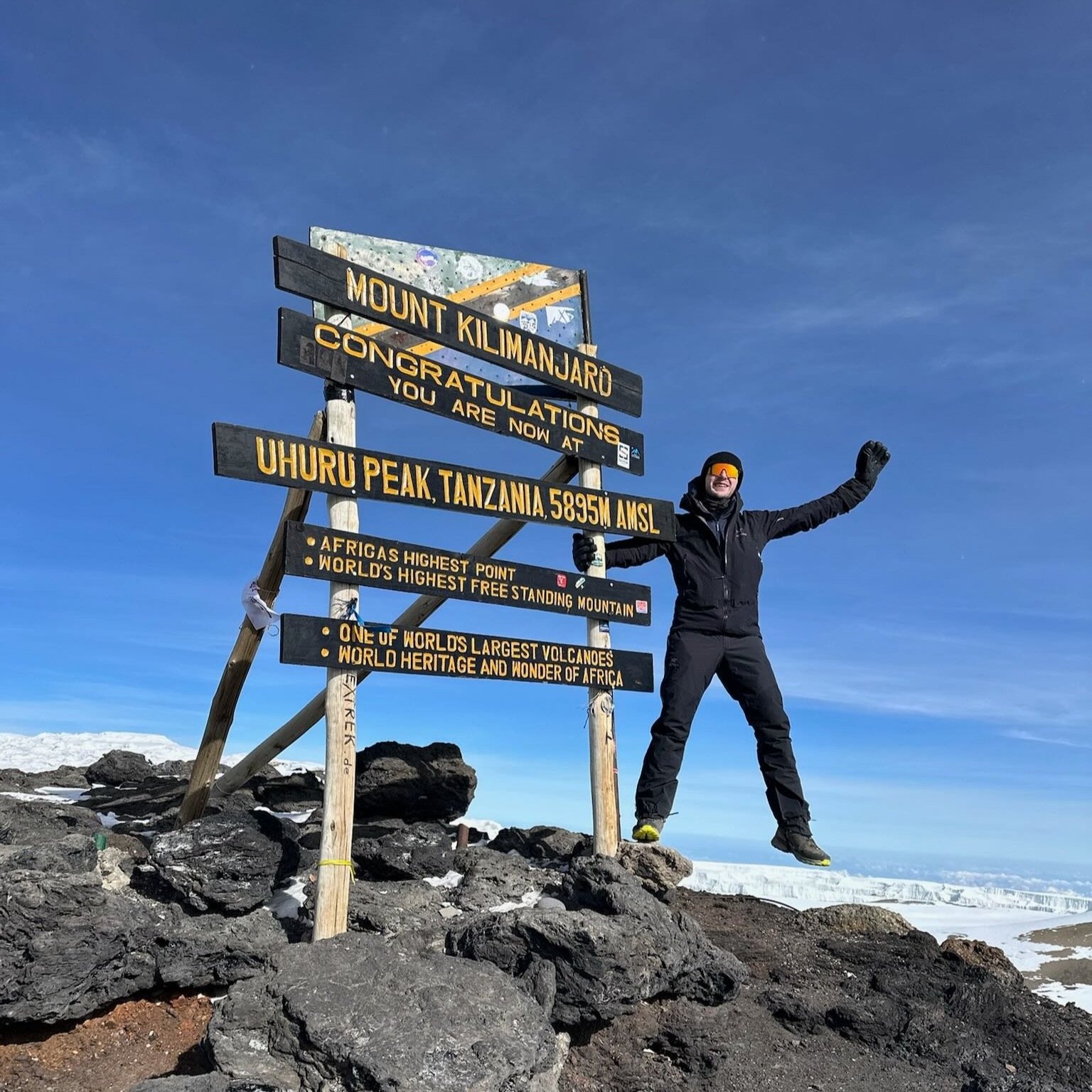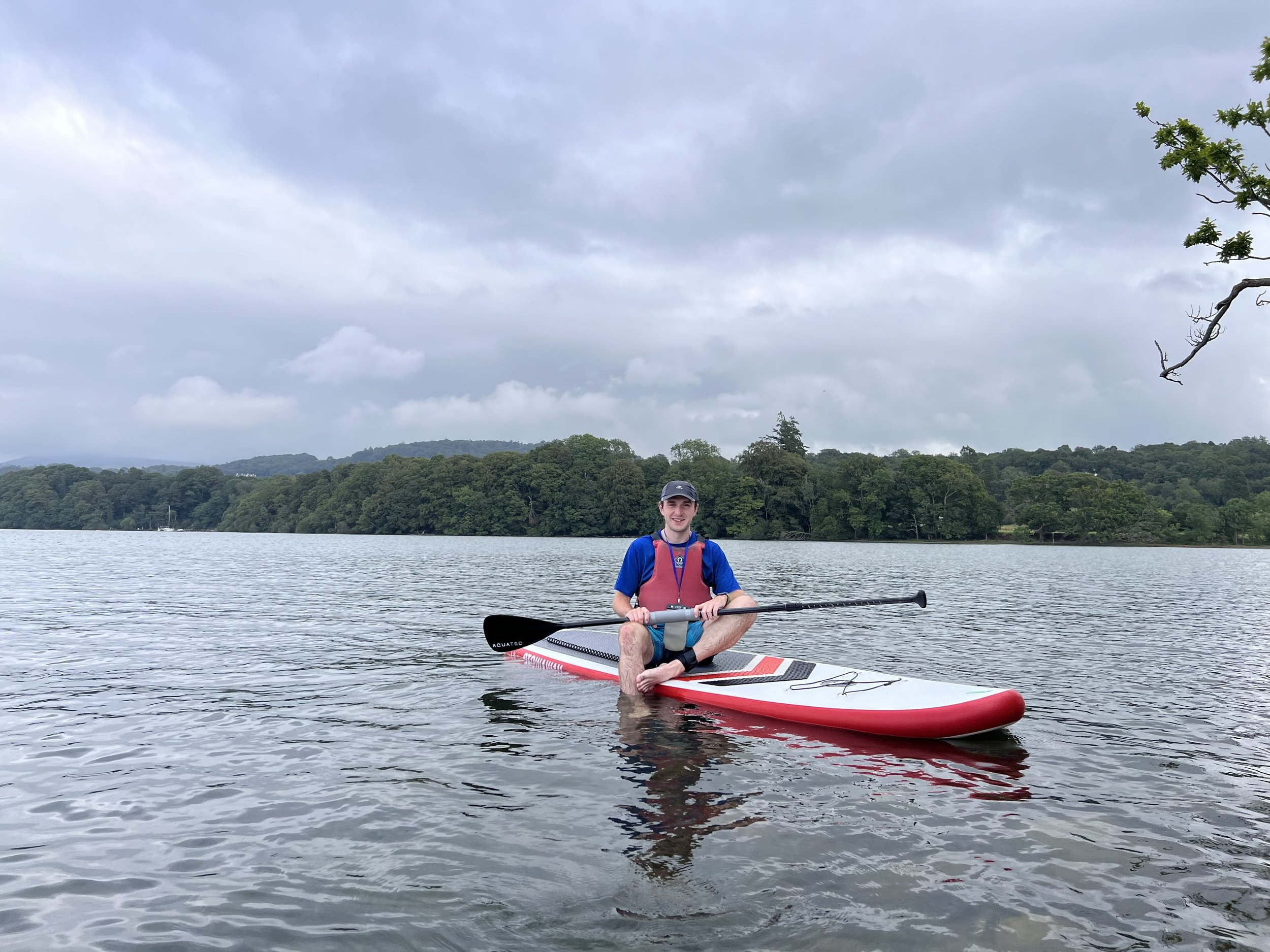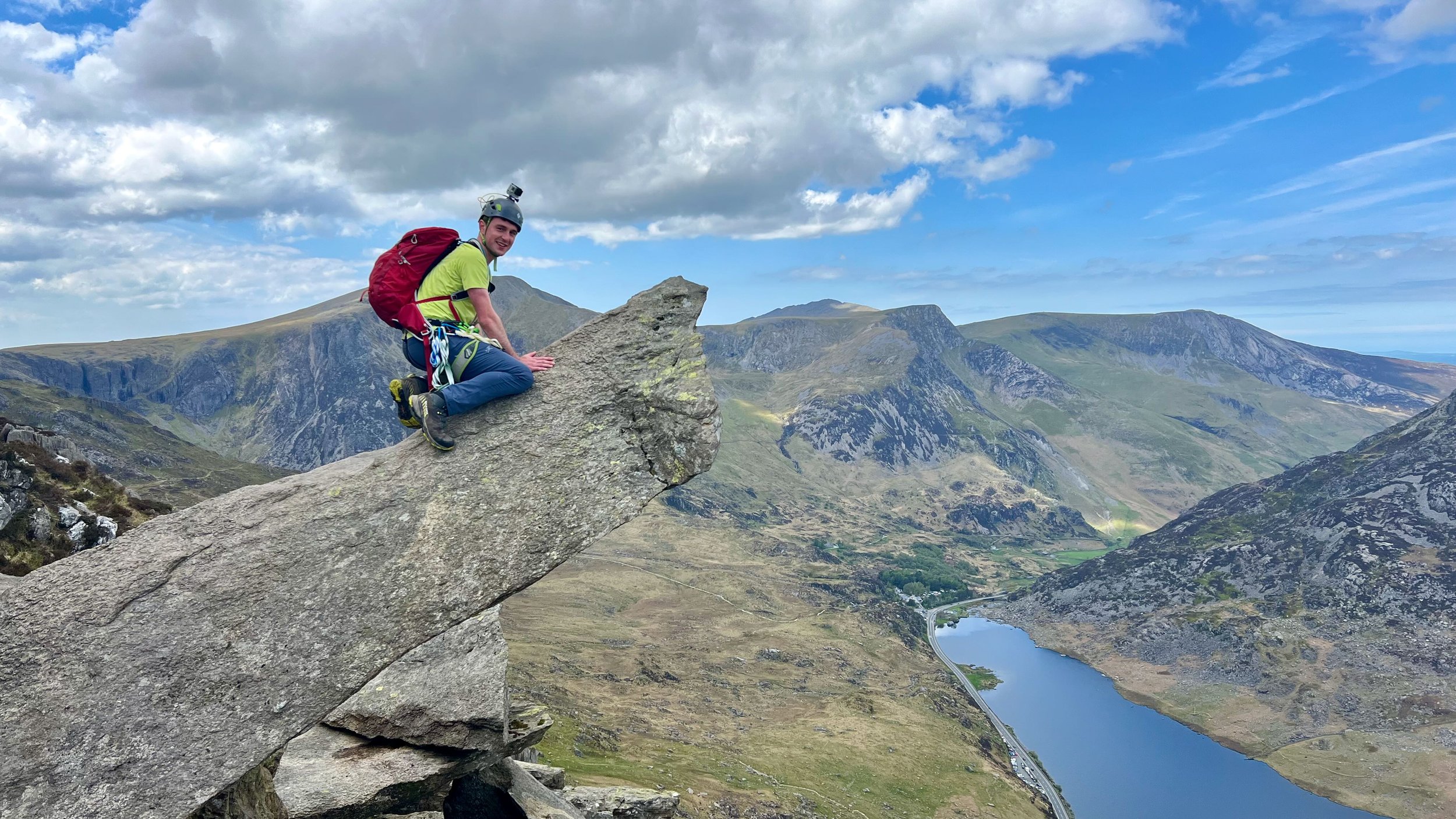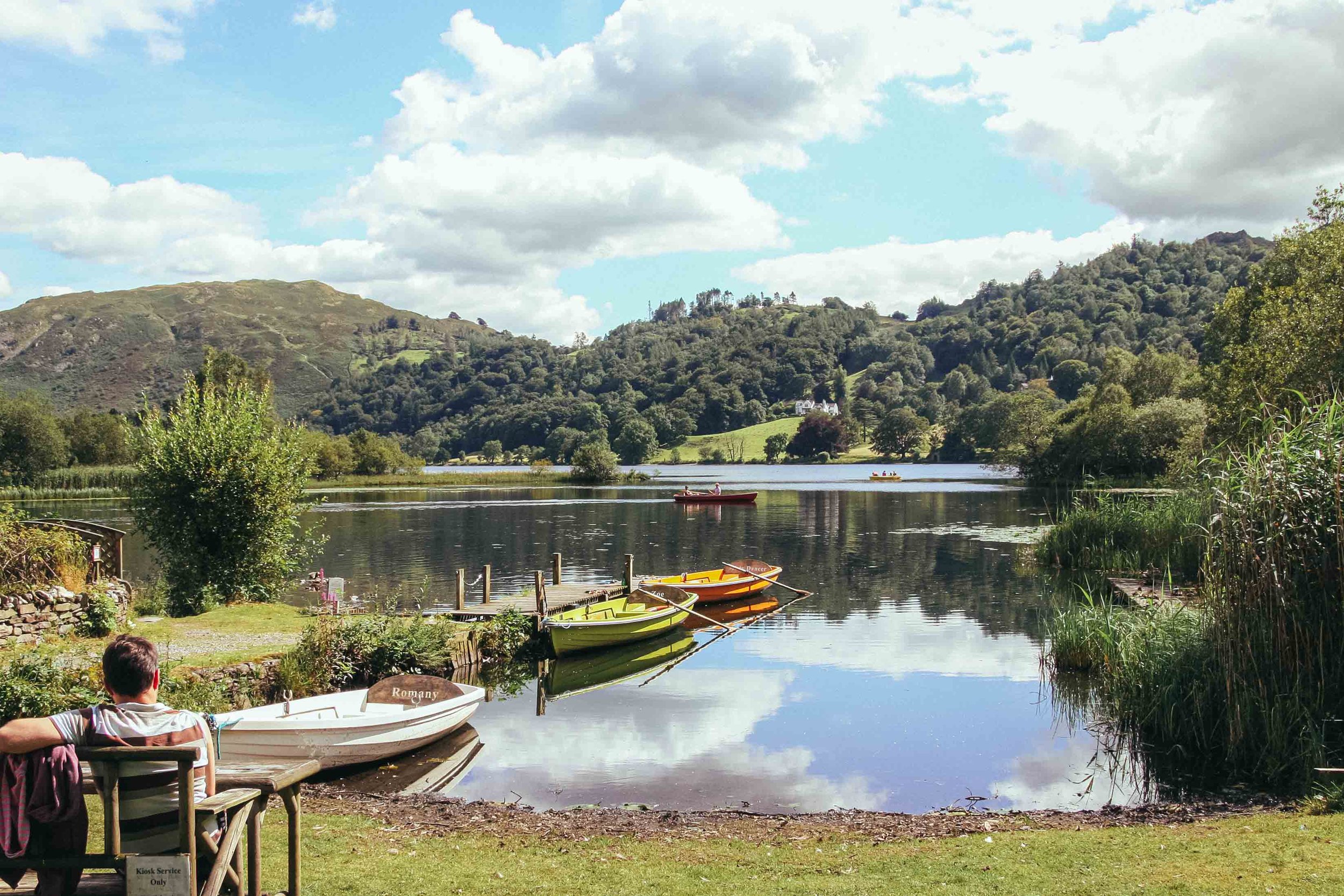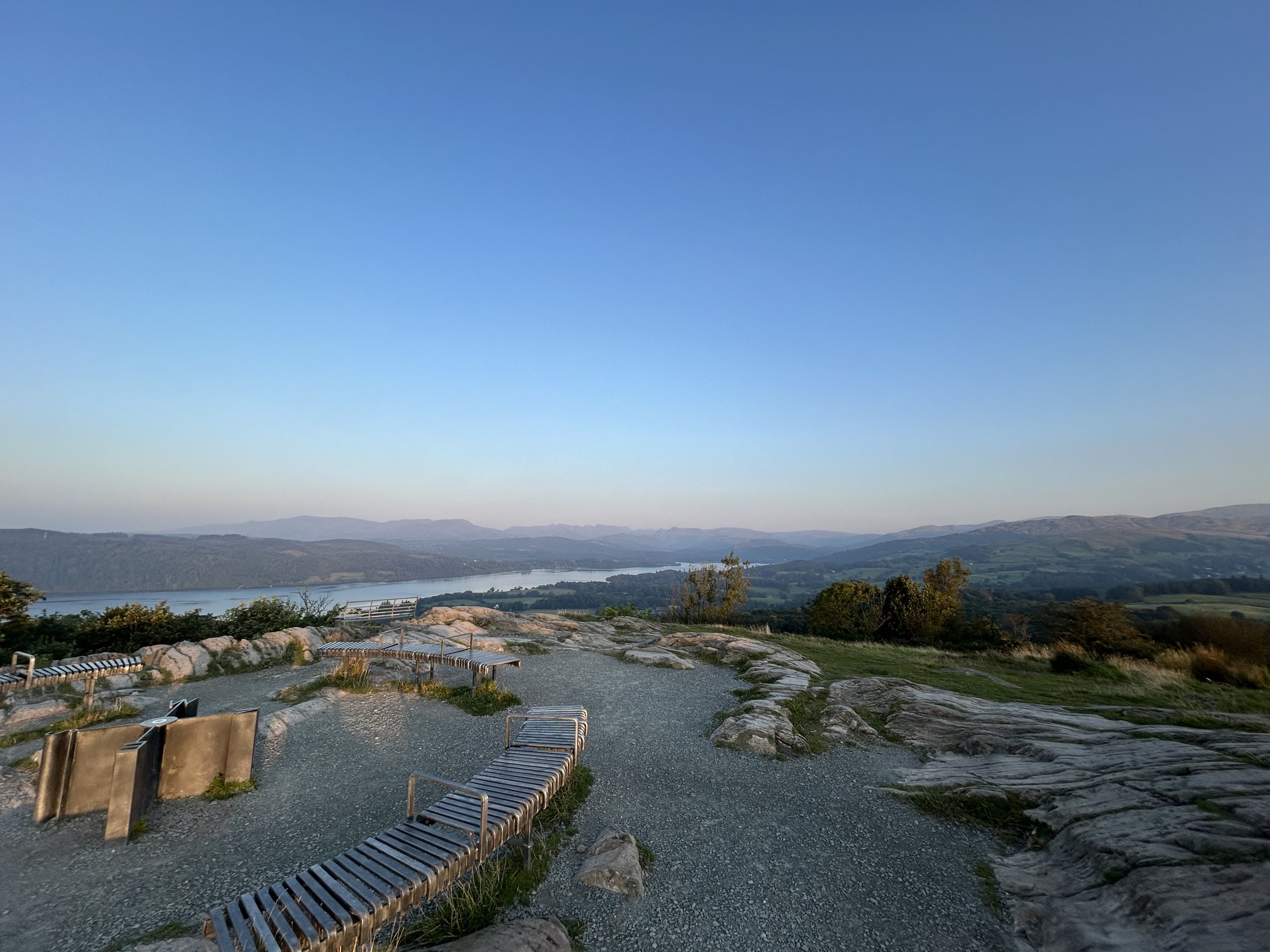Conquering Kilimanjaro: A Journey to the Roof of Africa
Climbing Mount Kilimanjaro via the 8 day Lemosho Route
Standing at the top of Uhuru Peak, Kilimanjaro
Just a few weeks ago, I returned from the adventure of a lifetime: climbing Mount Kilimanjaro, Africa’s highest mountain and the world’s tallest free-standing peak.
It was, without a doubt, the most incredible trip I’ve ever experienced. From the breathtaking landscapes to the camaraderie of the climb, every moment was unforgettable.
Here’s how it all went.
Arrival in Tanzania
We touched down at Kilimanjaro Airport after a short flight from Kenya, buzzing with excitement and anticipation. Our driver from Altezza Travel greeted us warmly and whisked us off to the Aishi Machame Hotel, our base for the next two nights.
Nestled amidst the rainforest, the hotel’s setting was idyllic. With a pool, bar, and plenty of green space, it was an incredible place to relax ahead of eight days on the mountain.
To our surprise, monkeys swung from the trees, occasionally venturing down to the pool area to entertain the guests.
Altezza Travel were incredibly thorough with preparing us for the trip. They conducted an initial briefing at the hotel, walked us through what to expect, and did a full kit inspection to ensure we had all that we needed before departing.
Day 1: Into the Rainforest
After a decent breakfast mostly made up of pancakes and Nutella, we left the hotel for the two-hour drive to Londorossi Gate, the starting point of our hike. The scene at the gate was electric—hundreds of porters busily organising gear, preparing to support climbers like us on their hike to the summit.
Our first challenge was the rainforest, the first of Kilimanjaro’s five climate zones. The 7km hike to Mti Mkubwa Camp was relatively short, with a 400m elevation gain, but it offered a taste of what was to come. The route twisted its way through the forest, and for the first time, we got to experience the highway that is the route up. We saw several groups on the way and were passed by many porters who made light work of the hike up.
Surrounded by towering trees and monkeys, we reached our campsite under the forest canopy. That night, our chef, Edi, served up a delicious meal, giving us a glimpse of the fantastic mountain cuisine we’d enjoy throughout the trip. As we headed off to bed, the crew brought us hot water bottles which was a great treat to keep us toasty.
Day 2: Acclimatising on the Shira Plateau
Our first night on the mountain went surprisingly well, with most of us managing to catch at least a few hours of rest. Refreshed and ready, we set off from Mti Mkubwa Camp towards Shira 1 Camp, sitting at an elevation of 3,095m. This 7km trek marked our transition out of the dense rainforest and onto the start of the moorland.
The hike, which took about 5 hours, was a relatively gentle ascent—just enough to ease us into the higher altitude. Little did we know how much we’d appreciate this steady acclimatisation in the days to come.
As we stepped onto the vast, open landscapes of the Shira Plateau, we were rewarded with incredible views stretching in every direction. By the time we arrived at Shira Camp 1, a sense of accomplishment washed over us as we could see Kilimanjaro for the first time (unfortunately hidden by the clouds).
That evening, the clouds parted, revealing the silhouette of the mountain under a sky full of stars, and our first view of Kilimanjaro.
This was one of the best sights i’d ever seen.
Day 3: Spectacular Views at Shira Camp 2
Our hike continued to Shira Camp 2, sitting at 3,850m, over the moorland for another 10km. While today was probably the easiest day, the hike offered panoramic views of the African savannah and incredible vistas of Kilimanjaro which we never got board of.
We were even treated to a glimpse of Mount Meru, Tanzania’s second-highest peak, standing tall in the distance, surrounded by the clouds.
We made it to Shira Camp 2 after several hours of walking and were greeted with our first sunset on the mountain. With the silhouette of the jagged mountains in the foreground and the sun setting on the horizon, it was an unforgettable sight.
Sunset from Shira Camp 2
Day 4: Lava Tower
Me at Lava Tower at 4,600m
Day four was a big one!
Leaving Shira 2 Camp, we trekked towards the iconic Lava Tower up to 4,600m, and this is when we started to feel the first symptoms of altitude sickness. A big part of today was all about acclimatisation, hiking up to 4,600m and then back down in order to treck high but sleep low.
As we made our way up to Lava Tower, it started to snow, and once we made it to the top, the snow and wind had become heavy. Our porter team had laid out a fantastic spread of lunch upon our arrival—just what we needed after several hours of plodding.
Full of lunch, we started our decent to Barranco Camp (3,900m), passing through the striking alpine desert. This was a long plod down and by this point, we were ready for food and a warm brew.
The highlight of the day? Reaching camp and gazing up at the imposing Barranco Wall, our daunting challenge for the next morning.
Day 5: Climbing the Barranco Wall
Giving a helping hand on the way up the Barranco Wall
The day kicked off with an early start to tackle the infamous Barranco Wall—a towering expanse of boulders and steep rock faces demanding a mix of scrambling and careful climbing.
Despite its daunting appearance, the climb was far less intimidating than it looked. With steady effort, our group conquered it in just over an hour. The real marvel, though, was watching the porters navigate the wall with incredible ease, carrying heavy bags and kit on their shoulders as if it were second nature, while we cautiously picked our way along the rocky path.
The wall was alive with activity—hundreds of climbers funnelling through the same narrow track at the same time. At points, we found ourselves in queues, waiting patiently as the line shuffled forward.
Once we made it to the top, we paused for a tea break with the team. By then, the clouds had begun to roll in and visibility went to zero.
The trail beyond the Barranco Wall kept us guessing, with its constant ups and downs testing our stamina. Our guides set a steady, uplifting pace that kept morale high throughout.
After hours of trekking, we finally arrived at Karanga Camp, and it was breathtaking. In my opinion, it boasted the best views of the entire journey. Behind us, Kilimanjaro loomed, bathed in golden sunlight, while in front, the sprawling valley revealed Moshi far below. As night fell, the city’s twinkling lights sparkled in the distance—a humbling reminder of just how far we’d climbed from the world below.
Sunsetting over Kilimanjaro at Karanga Camp
Day 6: The Final Push to Barafu
Reaching Barafu Camp (Base Camp) at 4,673m was no easy feat!
The steep, unrelenting trail tested our endurance, but the effort was rewarded with awe-inspiring views of Moshi far below, a reminder of how far we’d come.
Barafu would be our launchpad for the ultimate challenge: the summit attempt. After arriving at camp, we paused for a quick tea break before heading out on an acclimatisation hike for another hour or so. This short but purposeful trek helped us gain valuable altitude and prepare our bodies for the night ahead.
That afternoon, the focus shifted to rest and recovery. We tried to get as much sleep as possible which was tricky in the afternoon, knowing that at 10pm, we’d begin the final ascent—a slow plod to the roof of Africa. The anticipation was palpable, and the challenge ahead loomed large, but so did the excitement of what lay above.
I think most of the group were feeling the nerves by this point, unknowing how we’d all feel on the way up and how hard it’d actually be. We had over 1,000m to climb that night, all the way up to 5,895m. It was not going to be easy.
Day 7: Summit Night and Uhuru Peak
The long line of head torches heading up to the summit
I’ve been fortunate enough to take on all kinds of adventures over the years—running up mountains in trail races, hiking endless trails, scrambling, and bouldering. But when I say this was the HARDEST challenge I’ve ever faced, I’m not exaggerating.
Summit night began at 10pm, beneath a breathtaking blanket of stars. With our guides and a handful of porters by our side, we started the slow, relentless ascent to Uhuru Peak. And when I say slow, I mean 8 long hours of placing one foot in front of the other and staring at the back of the person in front.
The air was thin, and every step felt like a monumental effort. Yet, the encouragement from our crew kept us moving forward. The porters were nothing short of extraordinary—right there with us, helping to navigate the steep scrambles and offering support at every turn.
This was the ultimate test of endurance, pushing us to our mental and physical limits.
As the first light of dawn crept over the horizon, we reached the summit—5,895m above sea level. Standing on the roof of Africa, watching the sun rise over the glaciers, was a surreal and emotional moment. This was the culmination of years of dreaming and planning, and it was everything I had hoped for. The weather was perfect, the views were otherworldly, and it’s a memory that will stay with me forever.
After soaking in the experience and celebrating with a bottle of fizz, it was time to begin the long descent back to Barafu Camp. I felt great initially—no headaches, no nausea, no signs of altitude sickness. But as we made our way down, the altitude started to take its toll. My appetite vanished, and the headache set in. Recognising the signs, I asked to descend quickly with a porter. Splitting off from the main group, we made a quick descent, and within 30 minutes, I felt like myself again. It’s incredible how quickly the effects of altitude can hit—and how quickly they can fade once you’re lower down.
That afternoon, we regrouped, had lunch, a short nap, and then began the trek to Millennium Camp at 3,950m, where we would spend the night. All in all, from starting our summit at 10pm to finally arriving at Millennium Camp the next day, we had covered over 15km and been on our feet for more than 15 hours. It was an enormous effort, and we were all deeply grateful to collapse into the warmth of the mess tent that afternoon.
Summit night was the hardest thing I’ve ever done, but it was also the most rewarding. It’s a reminder that the toughest challenges often lead to the most unforgettable moments.
Our view at 7am on the way up to the Kilimanjaro summit
Kilimanjaro’s glaciers sitting above the clouds
Day 8: The Final Descent
Our last day on the mountain took us from Millennium Camp, through the lush rainforest, and finally to Mweka Gate. By this point, the thought of a hot shower and a comfy bed was the only thing keeping us going. Despite being downhill, the descent on tired legs felt relentless and proved to be a challenge in its own right.
As we dropped in altitude, a sense of relief washed over us. The vibrant greenery of the rainforest felt like a warm embrace, welcoming us back to the world below after days in the stark, high-altitude landscape.
Reaching Mweka Gate was a moment of pure elation. We celebrated with our incredible guides and porters, whose support had been invaluable throughout the journey. Certificates in hand, we were overwhelmed by a profound sense of accomplishment, reflecting on the incredible adventure we had just completed. It was the perfect way to close out a life-changing experience.
Why Climb Kilimanjaro?
Climbing Kilimanjaro is so much more than a physical challenge.
The mountain pushes your endurance, resilience, and determination to their limits, but it also rewards you with breathtaking beauty and a sense of accomplishment that’s truly indescribable. If you’ve ever dreamed of standing on the roof of Africa or ticking off the Seven Summits, I can’t recommend this adventure enough.
Now, you might be thinking, “Ah, it’s just a hike.” Let me tell you—it was, and probably always will be, one of the most demanding challenges I’ve ever faced.
So, what’s next? Well, I’m setting my sights on the Seven Summits—the highest peak on each continent. One down, six to go. Want to follow along on this epic journey? Join the email newsletter below and come along for the adventure 😉.
Kilimanjaro FAQs: Everything you need to know before you climb
Where is Mount Kilimanjaro?
Mount Kilimanjaro is in Tanzania, East Africa, near the border with Kenya. If you're flying from Kenya, sit on the left-hand side of the plane for the best aerial views of Kilimanjaro as you approach Kilimanjaro International Airport (JRO).
How high is Mount Kilimanjaro?
Mount Kilimanjaro stands at 5,895 metres (19,341 feet) above sea level, making it Africa’s tallest mountain and the world’s highest free-standing mountain.
What equipment and kit do you need for Kilimanjaro?
Due to Kilimanjaro’s five climate zones, you need layered clothing to adjust to varying temperatures. You may start the day feeling cold but quickly warm up as you hike. Weather can change rapidly—one moment you’re in blazing sunshine, the next you’re layering up against rain, wind, or snow.
You can find my full Kilimanjaro kit list here.
What footwear is best for Kilimanjaro?
You need comfortable, durable hiking footwear that provides support, protection, and grip, as the terrain varies significantly.
I started day one and finished the last day in trail running shoes as the terrain was mostly paths. I also wore these shoes around camp. However, for the majority of the trek, I recommend waterproof hiking boots with ankle support. I used the Scarpa Rush Boots.
Should you take medication for altitude sickness on Kilimanjaro?
Altitude sickness can start at 2,500m and cause symptoms including headaches, nausea, and dizziness. The best way to acclimatise is to trek high and sleep low, and choose a longer route.
I took Diamox (Acetazolamide), which helps reduce altitude sickness symptoms and speeds up acclimatisation. I started taking half a tablet in the morning and half at lunch from day one. The only side effect was frequent urination, but this was a minor inconvenience compared to the benefits.
If you’ve already invested in the climb, I highly recommend taking Diamox to improve your chances of summiting and making the experience more enjoyable. You should be able to get this from your doctor.
How difficult is it to climb Mount Kilimanjaro?
Climbing Kilimanjaro is a challenging but achievable trek. The difficulty depends on your fitness level, the route you choose, and how well you acclimatise. The 8-day Lemosho Route, which I took, was a moderate trek with the summit day being the most demanding due to the long ascent in cold and windy conditions.
Each day involves hiking between 7-15 km at a slow, steady pace with plenty of breaks, including tea stops and toilet breaks. While I found most days relatively easy, summit night was one of the hardest things I’ve ever done—mainly due to the slow, gruelling plod in the early hours of the morning.
Altitude sickness affects most climbers to varying degrees. I personally didn’t suffer from it on the way up to the summit, but many in my group did.
What is the Lemosho Route like?
I climbed Kilimanjaro via the 8-day Lemosho Route, known for its beautiful landscapes, gradual ascent, and high success rate (~70%). This route offers excellent acclimatisation, increasing your chances of reaching the summit.
What is the best time to climb Kilimanjaro?
The best months to climb Kilimanjaro are January to March and June to October. These months offer dry weather, clear skies, and stable conditions.
I climbed between 5th and 13th January, and we had near-perfect weather—only one rainy night while we were in the tents. Mornings were mostly clear and cloud-free, while afternoons tended to be cloudy. Summit day was cold but calm, providing a stunning sunrise from the top.
How much does it cost to climb Kilimanjaro?
The cost of climbing Kilimanjaro varies depending on the tour company, flights, the route, and any optional add-ons you choose.
I climbed with Altezza Travel, which charged ~£2,500 for the 8-day Lemosho trek. This included:
All food and drinks on the mountain (breakfast, lunch, and dinner, plus tea stops)
Tents and camping mats
Transfers and accommodation before and after the trek, including airport transfers
Private toilets (we hired two for six people)
While cheaper options exist, I recommend investing in a quality tour operator for a more comfortable experience and a higher chance of summiting. Altezza was thorough with their kit checks, welfare, and medical checks throughout. They had a full first aid kit, AED, and medically trained staff.
A few of my other Kilimanjaro guides
I’ve put together a number of other guides to help you prepare for your trip to Kilimanjaro.
Read my other adventures from around the world
Fancy a trip to the Lake District?
Here are a few of my favourite hikes:














